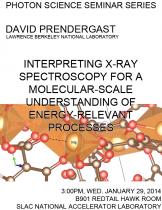Speaker: David Prendergast, Lawrence Berkeley National Laboratory
To enhance our ability to harvest and store energy and undesirable byproducts, we require a fundamental understanding of the working principles of promising and proposed materials systems. Key figures of merit related to device performance are quite often determined by atomic and molecular scale details of bonding and coordination. X-ray spectroscopies are actively being exploited to provide such detail, given their intrinsic elemental and chemical specificity. We have developed a first-principles approach to simulate X-ray absorption and photoemission spectra, which can make the necessary connection between measured spectra and underlying atomic and electronic structure. We have recently applied this approach to model the X-ray absorption spectra of solid state systems relevant to Li-ion batteries, revealing evidence for atomistic dynamics in our interpretation of spectral features. This work highlights how thermally-induced instantaneous symmetry breaking in the coordination of metal cations can be evident in their near-edge spectra. Similarly, static symmetry breaking is central to our ability to validate theoretical structural models for carbon dioxide adsorption within metal-organic frameworks by our interpretation of in situ X-ray absorption measurements. Finally, we provide theoretical bounds for the simulation of X-ray photoemission data using existing density functionals and use this capability to select a working hypothesis for photoinduced electron transfer from a dye molecule to a semiconducting oxide substrate, through interpretation of recent transient photoemission measurements at the Linear Coherent Light Source.





